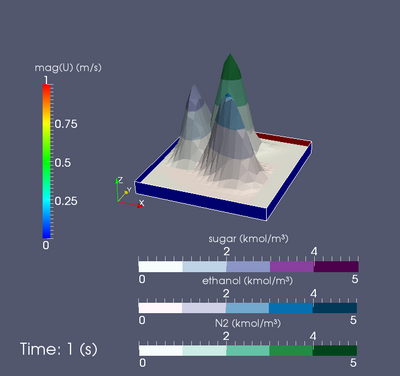How to add transport of N solutes to icoFoam
Before reading this tutorial, you should first understand how to add temperature to icoFoam. The idea here is the analogous, but in the case of solutions one can have an indefinite number of solutes dissolved in a solvent. The dissolution of different phases is not modelled here, therefore solute concentrations may not increase above solubility saturation (under saturation hypothesis).
Contents
1 solutionProperties dictionary
The solute list containing Fick's Law diffusion coefficients is defined in
case/constant/solutionProperties
Check the example below
sugar { diffusionModel constant; D D [0 2 -1 0 0 0 0] 5.2e-10; } ethanol { diffusionModel constant; D D [0 2 -1 0 0 0 0] 1.6e-9; } N2 { diffusionModel constant; D D [0 2 -1 0 0 0 0] 3.6e-9; }
(Obs.: diffusionModel is not used here, but as an exercise you could model a temperature sensitive diffusion or a diffusivity model for turbulent flow, etc.)
2 Time mesh dictionaries
You will have to create field dictionaries for each solute (e.g. sugar, ethanol, etc.). Because each solute field has dimensions of molar concentration (kmol/m³), the field names are defined as "C_{solute}" (e.g. 0/C_sugar).
3 setFields
I used setFields utility to set different concentrations in the internal field. Check
cavity/system/setFieldsDict
4 Container class solute
Now it is a good opportunity learn a little bit of class inheritance. Let's create a container class for each solute, where the diffusivity constants (D) are stored together with the volScalarFields (C_solute). The solute class inherits all properties of volScalarFields -- and was based on the "phase" class used in multiphase solvers.
The inheritance is defined in solute.H by declaring
class solute
:
public volScalarField
The solute is constructed entering the solute dictionary (sub-dictionary in solutionProperties-file) and the mesh.
Foam::solute::solute ( const dictionary& soluteDict, const fvMesh& mesh ) : volScalarField ( IOobject ( "C_" + soluteDict.dictName(), mesh.time().timeName(), mesh, IOobject::MUST_READ, IOobject::AUTO_WRITE ), mesh ), name_("C_" + soluteDict.dictName()), soluteDict_(soluteDict), D_(soluteDict_.lookup("D")), diffusionModel_(soluteDict_.lookup("diffusionModel")) { Info<< "Reading field " << name_ <<"\n" << endl; }
We are going to dynamically allocate memory to each solute. Therefore we will be using pointers, which makes it interesting to have an instances solute::clone() and solute::iNew.
Finally, don't forget to declare solute in the main solver header.
#include "solute.H"
5 createFields.H
First, let's have a look into createFields.H to understand how solutionProperties dictionary and the C_-fields are read.
// * * * * * * * * * * * * * Properties fields * * * * * * * * * * * * * * * // Info<< "Reading solutionProperties\n" << endl; IOdictionary solutionProperties ( IOobject ( "solutionProperties", runTime.constant(), mesh, IOobject::MUST_READ_IF_MODIFIED, IOobject::NO_WRITE ) ); const wordList soluteNameList(solutionProperties.toc()); PtrList<solute> soluteList(soluteNameList.size()); forAll(soluteNameList, i) { const word& soluteName = soluteNameList[i]; const dictionary& soluteDict = solutionProperties.subDict(soluteName); soluteList.set ( i, new solute ( soluteDict, mesh ) ); }
IOdictionary::toc() returns a wordList containing the table of contents (toc) of solutionProperties.
Next, a list of pointers to solute class having the size of the number of entries in the solutionProperties dictionary is defined, before dynamically allocating solutes in the list by the "new" operator.
6 Groups for discretization schemes and solution options
7 Files
Source files and example case: File:TransportIcoFoamN.tar.gz
